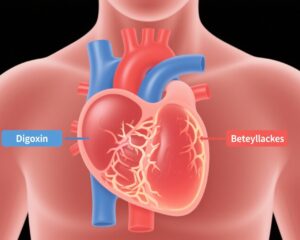Study background and disease burden
Heart failure (HF) constitutes a major global public health challenge, with increasing incidence, particularly among older adults. It is clinically categorized into heart failure with preserved ejection fraction (HFpEF) and heart failure with reduced ejection fraction (HFrEF), reflecting distinct pathophysiologies and treatment paradigms. Systolic function, conventionally assessed by left ventricular ejection fraction (LVEF), and diastolic function, commonly quantified by transmitral E/A ratio, evolve dynamically with aging and cardiac remodeling. The interplay between these functions over time influences the risk of developing heart failure subtypes; however, integrated longitudinal analyses capturing concurrent systolic and diastolic trajectories have been limited. Identifying distinct trajectories could augment risk stratification and offer mechanistic insights into heart failure development, aiding early intervention and therapeutic discovery.
Study design
This study utilized a Bayesian non-parametric trajectory modelling approach to jointly characterize longitudinal trajectories of LVEF and E/A ratio in late-life. Development trajectories were derived from 747 Jackson Heart Study (JHS) participants who underwent at least two echocardiograms between 2000 and 2019, covering ages approximately 65, 75, and 81 years. To extend generalizability and validate predictive capacity, the trajectory model was applied to 4419 participants from the Atherosclerosis Risk in Communities (ARIC) study based on single-time point echocardiographic measures at around age 75. Incident heart failure outcomes, separated into HFpEF and HFrEF subtypes, were captured prospectively. Multivariable Cox proportional hazards models assessed associations between predicted trajectory membership and heart failure risk. Furthermore, plasma proteomics profiling encompassing 4877 proteins was leveraged to identify proteins linked to specific trajectory patterns. Mendelian randomization analysis was used to explore potential causal effects of these protein markers on LVEF and left ventricular volume.
Key findings
Six distinct integrated trajectories of cardiac function emerged:
- Pink (50% prevalence): Increasing LVEF with decreasing E/A ratio over time, representing a normative aging pattern.
- Light green (17%): Increasing LVEF with gradually decreasing E/A ratio.
- Red (22%): No increase in LVEF; relatively stable or non-improving systolic function.
- Dark green (4%): Declining LVEF trajectory, indicative of systolic deterioration.
- Orange (2%): Steeply declining LVEF with rising E/A ratio, representing combined systolic decline and diastolic impairment.
- Blue (4%): Rising E/A ratio despite increasing LVEF, suggesting isolated or prominent diastolic dysfunction with preserved systolic improvement.
In the ARIC testing cohort, these trajectory memberships were differentially associated with heart failure subtypes. Specifically, the red and dark green groups correlated with incident HFrEF alone, signifying declining or impaired systolic function as a precursor. The blue trajectory was linked exclusively with HFpEF, emphasizing diastolic dysfunction as a key driver in preserved ejection fraction heart failure. The orange trajectory showed significant associations with both HFpEF and HFrEF, reflecting combined systolic and diastolic deterioration.
Importantly, incorporating trajectory membership into predictive models improved discrimination and risk stratification for both heart failure overall and HFpEF specifically. This demonstrates added clinical utility beyond single-time-point cardiac function measures.
Proteomic analysis identified 13 plasma proteins with significant associations to these cardiac trajectories. Mendelian randomization suggested potential causal effects of a subset of these proteins on LVEF and left ventricular volume remodeling, highlighting novel biomolecular pathways that could serve as future therapeutic targets or biomarkers.
Expert Commentary
The application of Bayesian non-parametric methods to jointly model systolic and diastolic function trajectories offers a refined perspective on cardiac aging and heart failure risk beyond traditional static measurements. The identification of distinct trajectory phenotypes aligned with known clinical entities reinforces the pathophysiological heterogeneity underpinning HFpEF versus HFrEF. This approach enables personalized risk prediction and highlights the temporal dynamics of cardiac function, which are crucial for timely intervention.
The integration of extensive proteomics data adds mechanistic depth and translational potential, pointing towards targetable molecules involved in myocardial remodeling processes. However, some limitations should be acknowledged. The study populations, while diverse, may limit generalizability to other ethnic groups or younger individuals. Echocardiographic measures such as E/A ratio can be influenced by loading conditions and have technical variability, which might affect trajectory classification. Future work should validate these trajectories in independent cohorts and explore the impact of interventions on altering trajectory patterns.
Conclusion
This study advances our understanding of heart failure pathogenesis by delineating integrated systolic and diastolic function trajectories in late life that differentially predict HFpEF and HFrEF. Bayesian modelling provides a robust tool for capturing complex longitudinal cardiac changes, enhancing risk stratification and enabling discovery of proteomic biomarkers with potential causal roles. Incorporating such trajectory-based assessments into clinical practice could improve early identification of at-risk individuals and guide precision medicine approaches. Continued research is warranted to translate these findings into therapeutic strategies that modify adverse cardiac trajectories and improve outcomes in heart failure.
References
Reimer Jensen AM, Ross JC, Arthur V, Hall ME, Matsushita K, Lennep B, Lutsey PL, Biering-Sørensen T, Shah AM. Integrated trajectories of systolic and diastolic function differentially associate with risk for heart failure with preserved and reduced ejection fraction and proteomic profiles. Eur J Heart Fail. 2025 Sep 2. doi:10.1002/ejhf.70015. Epub ahead of print. PMID: 40891821.
McDonagh TA, Metra M, Adamo M, et al. 2021 ESC Guidelines for the diagnosis and treatment of acute and chronic heart failure. Eur Heart J. 2021;42(36):3599-3726.
Borlaug BA, Paulus WJ. Heart failure with preserved ejection fraction: pathophysiology, diagnosis, and treatment. Eur Heart J. 2011;32(6):670-679.
Clerkin KJ, Gerber IL, Meadows C, et al. Proteomics and the heart: promising new directions for translational cardiovascular medicine. Circulation. 2014;129(13):1342-1356.



